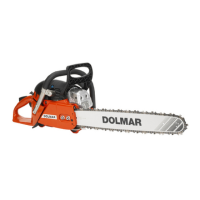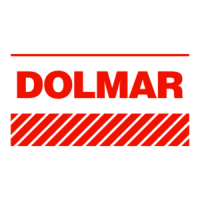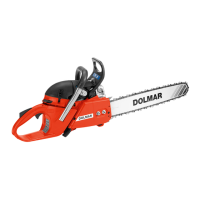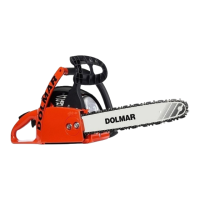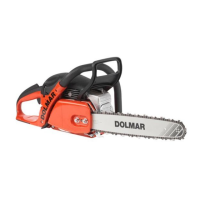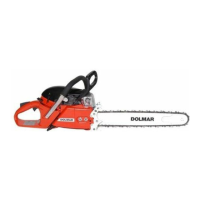Operator’s and Safety Manual
for Gasoline Chain Saws (page 2 - 39)
Manuel d’emploi et de sécurité
de tronçonneuses thermiques (page 40- 77)
WARNING!
Read and understand this Manual. Always follow safety precautions in the Operator’s and Safety Manual. Improper use can cause serious injury! Preserve this Manual carefully!
WARNING!
FUELS WITH MORE THAN 10% ETHANOL ARE NOT APPROVED FOR USE IN DOLMAR 2-STROKE ENGINES!
Use of alternative fuels, such as E-20 (20% ethanol), E-85 (85% ethanol) or any fuels not meeting DOLMAR requirements are not approved for use in DOLMAR 2-stroke gasoline engines!
USE OF ALTERNATIVE FUELS CAN CAUSE THE FOLLOWING PROBLEMS:
Poor engine performance, loss of power, overheating, fuel vapor lock, improper clutch engagement, premature deterioration of fuel lines, premature deterioration of gaskets,
premature deterioration of carburetors.
USING ALTERNATIVE FUELS AND/OR 2-STROKE OILS NOT ACCORDING TO JASO FC OR ISO-L-EGD IN DOLMAR 2-STROKE ENGINES WILL VOID YOUR ENGINE WARRANTY!
ATTENTION!
Suivez toujours les conseils de sécurité du présent manuel d’emploi et de sécurité. Une utilisation incorrecte de la tronçonneuse peut entraîner des blessures graves!
Lisez et comprenez ce manuel. Conservez avec soin ce manuel!
ATTENTION!
LES CARBURANTS CONTENANT PLUS DE 10 % D’ÉTHANOL NE SONT PAS AUTORISÉS POUR L’UTILISATION DANS LES MOTEURS 2 TEMPS!
Les carburants alternatifs, tels que E-20 (20 % d‘éthanol), E-85 (85 % d’éthanol) ou tout autre carburant n’étant pas conformes aux exigences DOLMAR ne sont pas autorisés
pour l’utilisation dans les moteurs essence à 2 temps DOLMAR!
L’UTILISATION DE CARBURANTS ALTERNATIFS PEUT CAUSER LES PROBLÈMES SUIVANTS:
Faible performance moteur, Perte de puissance, Surchauffe, Bouchons de vapeur dans la conduite d’essence, Embrayage incorrect, Détérioration prématurée des conduites
d’essence, Détérioration prématurée des joints d’étanchéité, Détérioration prématurée des carburateurs.
L’UTILISATION DE CARBURANTS ALTERNATIFS ET/OU D’HUILES 2 TEMPS NON-CONFORMES À LA NORME JASO FC OU ISO-L-EGD DANS LES MOTEURS À 2 TEMPS
DOLMAR ANNULERA VOTRE GARANTIE MOTEUR!
PS-7310, PS-7310 H
PS-7910, PS-7910 H
PS-7910 XD, PS-7910 HXD
PS-7910 WXD
